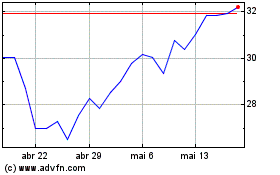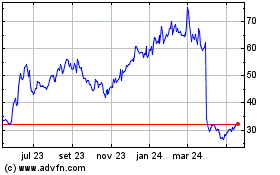Disc Medicine, Inc. (NASDAQ:IRON), a clinical-stage
biopharmaceutical company focused on the discovery, development,
and commercialization of novel treatments for patients suffering
from serious hematologic diseases, today spotlights 8 posters
presented at the ASH 2024 annual meeting in San Diego, CA. This
year’s presentations included updates from the BEACON and AURORA
trials of bitopertin in patients with erythropoietic protoporphyria
(EPP) and the Phase 1 SAD/MAD trial of DISC-3405 in healthy
volunteers. Additionally, Disc presented a real-world patient
survey highlighting the disease burden of EPP and multiple
preclinical models highlighting the potential benefits of
bitopertin, DISC-0974, and DISC-3405 in existing and new
indications. The collection of data supports Disc’s continued
advancement of all three clinical candidates and provides evidence
for expansion opportunities in new indications.
In addition to its poster presentations, Disc
presented complete results from the Phase 1b trial of DISC-0974 in
anemia of myelofibrosis (MF) yesterday, December 8, in an oral
presentation. These results demonstrated positive impact on
clinically meaningful measures of anemia across a broad range of
patient types and support advancement of the program into a Phase 2
trial in MF anemia, which is now initiated. Management hosted a
call on Sunday, December 8 to review highlights of data presented
throughout the ASH meeting and plans for next steps in development.
The archive of the call is accessible on the Events and
Presentations page of Disc’s website
(https://ir.discmedicine.com/).
Bitopertin, DISC-0974, and DISC-3405 are
investigational agents and are not approved for use as therapies in
any jurisdiction worldwide.
Summary of Poster
Presentations
Bitopertin:
Disc is advancing development and registrational
activities for bitopertin in EPP, with the potential for
accelerated approval using PPIX as a surrogate endpoint.
AURORA:
The AURORA study is a randomized, double-blind,
placebo-controlled Phase 2 clinical trial that enrolled 75 adult
subjects with EPP. Subjects were randomized 1:1:1 to receive 20 mg
of bitopertin (n=26), 60 mg of bitopertin (n=25), or placebo (n=24)
orally once daily for 17 weeks.
- Updated analyses show that bitopertin reduced PPIX in all
prespecified subgroups across demographic and baseline patient
characteristics
- Previously presented analyses showed that reductions in PPIX
were associated with improvements in multiple clinical outcomes,
including measures of sunlight tolerance, reductions in phototoxic
reactions, and patient-reported quality of life
BEACON:
The BEACON study is a Phase 2, randomized,
open-label, multiple dose clinical trial that enrolled 22 adults
and 4 adolescents with EPP. Subjects were randomized 1:1 to receive
20 mg of bitopertin (n=14) or 60 mg of bitopertin (n=12) orally
once daily for 24 weeks.
- Updated analyses show that bitopertin significantly reduced
protoporphyrin IX (PPIX) at low and high doses and in both adult
and adolescent populations
- Bitopertin had a meaningful impact on light tolerance, with
similar benefit shown across adult and adolescent populations
- Reductions in PPIX were associated with improvements in
multiple measures of sunlight tolerance
- Bitopertin was generally well tolerated and showed a similar
safety profile in adults and adolescents
EPP LIGHT Study:
The EPP LIGHT Study is a patient survey study
seeking to comprehensively describe the burden of disease in adults
and adolescents with EPP.
- Across adult (n=164) and adolescent (n=33) respondents, EPP
symptoms impact all facets of life including ability to be out in
the sun for prolonged periods of time, ability to undertake daily
activities, deficits in emotional functioning, and absenteeism at
work and school
- 68% of adults and 45% of adolescents experienced pain from a
phototoxic reaction after <30 minutes in direct sunlight, and
recovery time was an average of 5.5 ± 4.8 days for adults and 5.1 ±
3.0 days for adolescents
- 75% of adults and 46% of adolescents reported feeling depressed
or sad and respondents reported substantially lower satisfaction
with social roles and higher feelings of social isolation than the
general population
- 23% of employed adults reported missing work in the past month
due to EPP; 24% of adults and 42% of adolescents attending school
at the time of the study reported missing school in the past month
due to EPP
Phototoxicity Study in Mouse Model of EPP:
The effects of an orally bioavailable glycine
transporter 1 (GlyT1) inhibitor, DISC-C, on PPIX levels and skin
phototoxicity induced by UV/blue light were evaluated in EPP mice.
Results showed:
- Treatment with a mouse analog of bitopertin caused a 37-40%
decrease in PPIX levels in red blood cells
- GlyT1 inhibition significantly reduced skin lesions after light
exposure; treated mice developed skin lesions in 9.2% of exposed
skin area vs. 51.2% in placebo
- Percentage of area with skin lesions correlated with PPIX
levels, supporting PPIX as the pathological driver of phototoxicity
in EPP
DISC-0974:
DISC-0974+Ruxolitinib Mouse Model:
Wild-type mice were randomized to receive doses of
placebo, ruxolitinib, DBIO-100 (a mouse analog of DISC-0974), or a
combination of ruxolitinib and DBIO-100. Results showed:
- Ruxolitinib treatment alone reduced hemoglobin by 1.2 g/dL in
wild-type mice, inducing anemia
- Adding treatment with DBIO-100 had a positive impact on anemia,
increasing hemoglobin by 0.8 g/dL and further enhancing serum iron
availability
These results highlight the potential for DISC-0974
to treat anemia of myelofibrosis (MF) in patients where
disease-directed therapies such as ruxolitinib can significantly
contribute to the development of anemia.
DISC-0974 in a Mouse Model of Inflammatory Bowel
Disease (IBD)
The effect of DISC-0974 on improving anemia in a
dextran sodium sulfate (DSS)-induced colitis mouse model was
evaluated. Results showed:
- Treatment with DBIO-100 (a mouse analog of DISC-0974)
suppressed hepcidin, increased serum iron, increased hemoglobin by
up to 6 g/dL, and effectively alleviated anemia in IBD mice
- Treated mice also experienced protective effects against IBD,
evidenced by attenuated weight loss, decreased disease activity
index score, preserved colon length, improved colon histopathology,
and reduced markers of inflammation
These results highlight the potential value of
DISC-0974 in treating anemia of chronic inflammatory diseases, such
as IBD, and add to the body of evidence supporting the application
of DISC-0974 to broadly address anemia of inflammation.
DISC-3405:
Healthy Volunteer Study:
Complete SAD/MAD data from the Phase 1 trial of
DISC-3405 in healthy volunteers were presented. In the SAD portion
of this trial, healthy males and females ages 18 to 65 were given a
single dose of placebo (n=10) or DISC-3405 at 75 mg intravenously
(IV) (n=6), 37.5 mg subcutaneously (SC) (n=6), 75 mg SC (n=6), 150
mg SC (n=6), or 300 mg SC (n=6). The MAD portion included placebo
(n=4), 75 mg SC (n=6), and 150 mg SC (n=6) cohorts dosed every 4
weeks for a total of 2 doses. Results showed:
- DISC-3405 produced dose-related increases in serum hepcidin
with corresponding reductions in serum iron across all dose
levels
- DISC-3405 resulted in deep reductions in serum iron (ranging
from 50-80% from baseline) that were sustained and support a
once-monthly SC dosing regimen
- Single and repeat dosing of DISC-3405 demonstrated meaningful
reductions in hematologic parameters, including reticulocyte
hemoglobin, hemoglobin, and hematocrit
- DISC-3405 was generally well-tolerated at all evaluated dose
levels, with no serious adverse events (AEs), greater than Grade 2
AEs, or AEs leading to study withdrawal
These results support Disc’s plans to advance the
DISC-3405 program into a Phase 2 study in polycythemia vera in
2025.
SCD Mouse Model:
The effect of DISC-3405 in the Townes mouse model
of SCD was evaluated. Results showed:
- Treatment with 10 mg/kg dose of a mouse analog of DISC-3405
resulted in iron restriction and a significant decrease in
hemoglobin S (HbS) concentration without affecting red blood cell
counts
- Also observed a significant decrease in lactate dehydrogenase
(LDH), suggesting decreased hemolysis, and decrease in white blood
cells, suggesting reduced inflammation
These results highlight the potential value of
DISC-3405 in providing therapeutic benefits to SCD patients by
reducing HbS concentration within red blood cells.
About Disc Medicine
Disc Medicine is a clinical-stage biopharmaceutical
company committed to discovering, developing, and commercializing
novel treatments for patients who suffer from serious hematologic
diseases. We are building a portfolio of innovative, potentially
first-in-class therapeutic candidates that aim to address a wide
spectrum of hematologic diseases by targeting fundamental
biological pathways of red blood cell biology, specifically heme
biosynthesis and iron homeostasis. For more information, please
visit www.discmedicine.com.
Disc Cautionary Statement Regarding
Forward-Looking
Statements
This press release contains “forward-looking
statements” within the meaning of the Private Securities Litigation
Reform Act of 1995, including, but not limited to, express or
implied statements regarding Disc’s expectations with respect to
the next stages of its development programs in EPP, MF and
polycythemia vera, and with respect to the potential of its
development programs in new indications. The use of words such as,
but not limited to, “believe,” “expect,” “estimate,” “project,”
“intend,” “future,” “potential,” “continue,” “may,” “might,”
“plan,” “will,” “should,” “seek,” “anticipate,” or “could” or the
negative of these terms and other similar words or expressions that
are intended to identify forward-looking statements.
Forward-looking statements are neither historical facts nor
assurances of future performance. Instead, they are based on Disc’s
current beliefs, expectations and assumptions regarding the future
of Disc’s business, future plans and strategies, clinical results
and other future conditions. New risks and uncertainties may emerge
from time to time, and it is not possible to predict all risks and
uncertainties. No representations or warranties (expressed or
implied) are made about the accuracy of any such forward-looking
statements.
Disc may not actually achieve the plans, intentions
or expectations disclosed in these forward-looking statements, and
investors should not place undue reliance on these forward-looking
statements. Actual results or events could differ materially from
the plans, intentions and expectations disclosed in the
forward-looking statements as a result of a number of material
risks and uncertainties including but not limited to: the adequacy
of Disc’s capital to support its future operations and its ability
to successfully initiate and complete clinical trials; the nature,
strategy and focus of Disc; the difficulty in predicting the time
and cost of development of Disc’s product candidates; Disc’s plans
to research, develop and commercialize its current and future
product candidates; the timing of initiation of Disc’s planned
preclinical studies and clinical trials; the timing of the
availability of data from Disc’s clinical trials; Disc’s ability to
identify additional product candidates with significant commercial
potential and to expand its pipeline in hematological diseases; the
timing and anticipated results of Disc’s preclinical studies and
clinical trials and the risk that the results of Disc’s preclinical
studies and clinical trials may not be predictive of future results
in connection with future studies or clinical trials and may not
support further development and marketing approval; and the other
risks and uncertainties described in Disc’s filings with the
Securities and Exchange Commission, including in the “Risk Factors”
section of our Annual Report on Form 10-K for the year ended
December 31, 2023, and in subsequent Quarterly Reports on Form
10-Q. Any forward-looking statement speaks only as of the date on
which it was made. None of Disc, nor its affiliates, advisors or
representatives, undertake any obligation to publicly update or
revise any forward-looking statement, whether as result of new
information, future events or otherwise, except as required by
law.
Media Contact
Peg RusconiDeerfield
Grouppeg.rusconi@deerfieldgroup.com
Investor Relations Contact
Christina TartagliaPrecision
AQchristina.tartaglia@precisionaq.com
Disc Medicine (NASDAQ:IRON)
Gráfico Histórico do Ativo
De Dez 2024 até Jan 2025

Disc Medicine (NASDAQ:IRON)
Gráfico Histórico do Ativo
De Jan 2024 até Jan 2025
